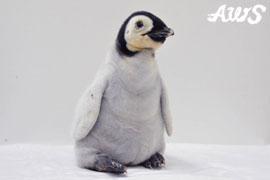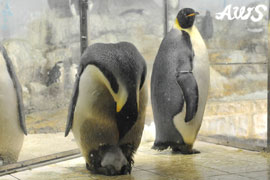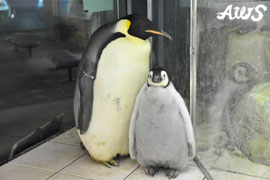Safari&Marineエンペラーペンギン 自然育雛への挑戦

2012年10月11日、アドベンチャーワールドで7例目となるエンペラーペンギンのヒナが誕生しました。体重は305g、孵化直後から元気な鳴き声を響かせていました。
エンペラーペンギンは巣を作らず、足の上で抱卵・育雛を行うペンギンです。そのため、巣を作るペンギンに比べ卵が割れたり、孵化直後のヒナが親鳥によって圧死する確率が高くなってしまいます。国内で21羽しか飼育されていないエンペラーペンギンを確実に増やすために、過去の6羽のヒナはスタッフが親代わりになって育てました。この6羽の人工育雛はすべて成功しましたが、人への刷り込み(生まれて最初に動く物体を親として覚え込む現象)が見られ、成鳥になっても繁殖にまで繋がっていません。
そこで次へのステップとして、エンペラーペンギン親子本来の姿である“自然育雛(親鳥に育てさせること)”に初めて挑戦することにしました。産卵後親鳥には擬卵(偽物の卵)を抱かせ、孵卵器で孵化させ、初めのうちだけ人工育雛を行い、ヒナの体格がしっかりした頃(生後10日頃)に擬卵と交換でヒナを親鳥の元へ戻す方法を取ることにしました。

◆ヒナを親鳥の元へ◆
10月21日(生後10日)ヒナは体重486gに増え、首も座りしっかりとしてきました。ついに、自然育雛への挑戦です。
展示場の一画に自然育雛専用のスペースを特別に設置し、最初は抱卵しているオス親のみをスペース内に移動し、ヒナを託すことにしました。育雛スペース内までヒナを運び、飼育スタッフ3人がかりで、親鳥の足の上にヒナを置きました。親鳥は特に暴れる様子もなく、初めて抱くヒナを自らのクチバシで何度も確認していたため、まずはひと安心しました。ところが、その後ヒナは時折鳴くものの、頭を出して餌を要求するといった姿は見られませんでした。
翌朝まで親子の様子を観察していましたが、オス親からの給餌は見られなかったため、次にメス親をスペース内に移動し、オス親・メス親の3羽で同居させてみました。その瞬間、オス親とメス親が鳴き合い、それに同調したかのようにヒナも鳴きました。しかししかしは見られるものの、親鳥からの給餌は確認出来ませんでした。その後も観察を続けましたが、やはり親鳥からの給餌が見られなかったため、自然育雛は断念し、再び人工育雛に切り替えました。

◆今後の課題◆
これまでのヒナは生後1年半頃に、他の成鳥と同居を行っていましたが、今回は生後2ヶ月で、成鳥と同居しました。成鳥と比較することで体の模様や大きさの違いをお客様にご覧いただけると共に、少しでも早い時期に他のペンギンと接することにより、将来の繁殖に繋がるのでは?と考えました。
今回、“エンペラーペンギンの親鳥に、ヒナを託す”という、新たな試みのまず一歩を踏み出すことが出来ました。「どうしたら親鳥がヒナに給餌を行うか」ということが、今後の最大の課題です。
(津久井 健太)

